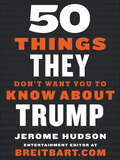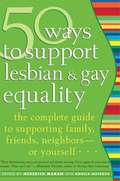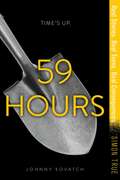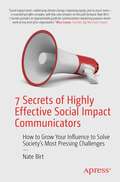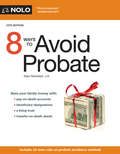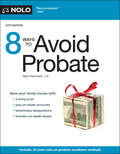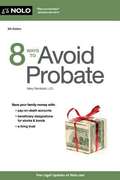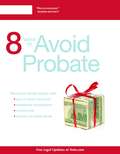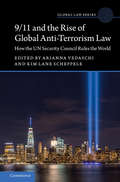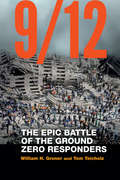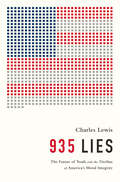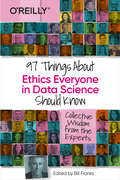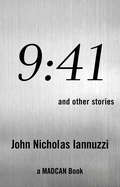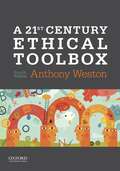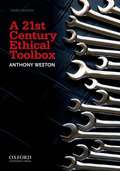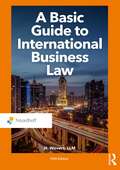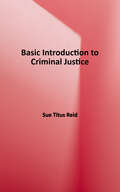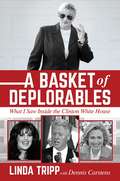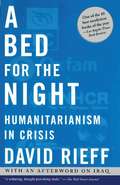- Table View
- List View
50 Things They Don't Want You to Know About Trump
by Jerome HudsonBreitbart.com editor Jerome Hudson returns with even more red pills, facts, and statistics to counteract the lies and blind spots of the mainstream media.Did you know Donald Trump has allocated more funding to historically black colleges and universities than any other president?In 50 Things They Don’t Want You to Know About Trump, Jerome Hudson uncovers all the things Americans have not been told about our 45th president. We’re surrounded by supposed influencers shouting about the scandals that Americans care about the least, from TV talking heads to social media activists, from feckless Washington swamp monsters to candidates fighting for the soap box.Your teachers, your politicians, and your local paper are not likely to ever tell you:Drug overdoses dropped for the first time in 30 years under Trump.America once again led the world in reducing carbon emissions in 2019.Trump is the first pro-gay marriage candidate elected president. (Obama endorsed it after his election.)Democrats backed out of attending an award ceremony from a criminal justice reform organization when they found out Trump won the award.The famous "Muslim ban" excluded 87 percent of the world's Muslims. Under Trump, blue-collar workers enjoyed three-times the wage growth of the top 1-percent of households.After finishing 50 Things They Don’t Want You to Know About Trump, you’ll be stunned at the many Trump accomplishments which just aren’t reported by the powers that be.
50 Ways to Support Lesbian and Gay Equality: The Complete Guide to Supporting Family, Friends, Neighbors or Yourself
by Meredith Maran Angela WatrousHomosexuality has been politicized. But when the issue hits home, whether it involves a family member, colleague, or neighbor who's gay, all that controversy fades in the face of a real, live person who wants and deserves basic human rights and freedoms. Written by gay, lesbian, bisexual, and transgendered people and those who care about them, 50 Ways to Support Lesbian and Gay Equality is a compendium of informative, joyful, and poignant essays by well-known experts, activists, and leaders, each promoting understanding while suggesting simple actions. From defining terminology ("What's gay baiting?"), to exploring family issues ("How can I support a lesbian couple who want to have children?"), the book deftly navigates workplace, cultural, and political issues. This timely and much-needed guide demonstrates positive ways to deal with everyday homophobia and heterosexism, or just plain uncertainty at the unfamiliar, offering guidance on issues ranging from the personal--what to say to a closeted friend --to the political--how to support gay rights around the world.
50 Years of Philosophy and Medicine (Philosophy and Medicine #150)
by Lisa M. Rasmussen Søren HolmThis volume celebrates the history of the Philosophy and Medicine series with a retrospective assessment of the impact of the series over 50 years, written by some who were involved from the beginning, and others who have been influenced by the series. The Philosophy of Medicine book series was founded in 1975, inspired by remarkable new technologies that challenged our understanding of medicine’s abilities and purpose. These technologies raised challenges that required deeper conceptual analysis and the tools of philosophy to address. Since its inception, the series has published 150 volumes addressing topics from assisted reproduction to end-of-life care; the history of medical ethics; international approaches to philosophy and medicine; clinical ethics and clinical judgment; brain death; and more. A must-read for anyone specializing in or interested in philosophy of medicine.
501 Practical Ways to Teach Your Children Values
by Bobbie ReedHow to teach your children values from a Biblical perspective
59 Hours (Simon True)
by Johnny KovatchReal stories. Real teens. Real consequences. An innocent teen becomes a hostage stuck in the middle of a dangerous drug-fueled feud in this third book in the chilling Simon True series.On Sunday, August 6, 2000, fifteen-year-old Nick Markowitz was grabbed off the street on the orders of a local drug dealer named Jesse James Hollywood. Nick was taken as collateral because his brother Ben owed Jesse money. He was an innocent victim who became a pawn in an increasingly high-stakes feud between the two that ended with Nick’s brutal murder. A dozen or more people saw Nick over the course of the next fifty-nine hours, but no one stepped forward to say anything. No one thought to report the crime to the police. Some of them were scared of Hollywood, while others simply didn’t want to get involved. When the news of Nick’s murder finally broke, they all had to confront what they’d done—or hadn’t done. As for Hollywood, he ordered the hit, but he wasn’t actually there when the murder took place. And once the story came to light, he immediately disappeared and remained a fugitive on the FBI’s Most Wanted List for nearly six years before his eventual capture.
7 Secrets of Highly Effective Social Impact Communicators: How to Grow Your Influence to Solve Society's Most Pressing Challenges
by Nate BirtSocial impact communication is quickly become a mandatory skill for leaders of modern businesses and nonprofits, at all levels of an organization. Yet using strategy, language and influence to advance game-changing societal breakthroughs isn’t something most people learn in college. This book provides a pathway for empathy, clarity and persuasive communication to advance the social impact work that can help people, their families and society.Too often, workplaces leave these essential capabilities to chance or trust osmosis to do the work. These aren’t skills you can learn in a classroom. They must be learned while actively engaged in the work of social impact leadership. Too many organizations treat social impact communication and programmatic leadership as “just another marketing project.” It’s a tremendous missed opportunity for businesses seeking to add value to society and deepen their client/customer relationships. What’s more, it directly damages other aspects of organizations’ ESG priorities— specifically, their cultivation of a healthy, safe and engaged workplace with team members whose personal values and professional activities are in harmony.Journalist and social impact business executive Nate Birt walks you through the essential mindset shifts and principles needed perform the social impact work that matters and have confidence your headed toward true north. The book includes firsthand insights, how-to strategies and social impact leadership anecdotes, along with insights and tips from dozens of social impact communicators whose perspective will provide you with real-world validation, strategies and encouragement. Each chapter includes a call for personal reflection or action that features a series of question-based prompts to encourage further introspection and journaling. At the end of the book, you'll get access to other resources to continue the conversation and professional development in the area of social impact communication.What You'll LearnUnderstand what makes social impact communication fundamentally different from conventional advertising, journalism or marketingSee why social impact communication requires translational communication capabilities within an organization, across partner stakeholders, and with external audiences, clients and customers.Examine how social impact communication cultivates more engaged leaders and teams by unlocking the power of team members’ individual values and personal purposeWho This Book Is ForSocial-impact executives and their teams in corporate or non-profit settings; non-ESG-focused executives seeking to better understand social impact and associated leadership/management strategies; college or university students seeking to specialize in social impact leadership; think-tank leaders, policymakers or others whose work intersects with social impact disciplines and decision-making.
75 Jahre Grundgesetz: Wie sich die Gewaltenteilung im Lauf der Zeit verändert hat
by Jochen TheurerDieses aufschlussreiche Buch beschreibt, wo und wie sich die Macht heute in Deutschland tatsächlich verteilt. Obwohl Art. 20 Abs. 2 GG noch genauso lautet wie 1949, hat sich das Verhältnis zwischen Exekutive, Legislative und Judikative zum Teil stark verändert. Beispielsweise ist das Bundesverfassungsgericht im Verhältnis zum Bundestag tendenziell mächtiger geworden und treibt das Parlament durch bahnbrechende Entscheidungen immer wieder vor sich her – vom Recht auf informationelle Selbstbestimmung über das „3. Geschlecht“ bis hin zum Klimaschutz. Zudem spielen internationale Player eine immer größere Rolle: War das Grundgesetz vor 75 Jahren die höchste Rechtsnorm in Deutschland, bestreitet mittlerweile kein Jurist mehr ernsthaft den Vorrang von EU-Recht vor der deutschen Verfassung. Dieser informative Einblick in die komplexe Welt des Rechts stellt anschaulich dar, wie sich der Inhalt von Gesetzen trotz identischem Wortlaut verändern kann.
8 Ways to Avoid Probate
by Mary RandolphBy taking some simple steps now, you can spare your family and beneficiaries a lot of time and money. How much? Probate court proceedings after a death can drag on for a year and cost tens of thousands of dollars--money that would otherwise have gone directly to your loved ones. 8 Ways to Avoid Probate offers easy and effective ways to skip the probate process so that property goes directly to the intended beneficiaries. Using the simple, plain English instructions, you'll learn how to create a savvy estate plan. Find out about: naming payable-on-death beneficiaries for financial accounts owning property jointly leaving real estate with transfer-on-death deeds using a living trust naming the right beneficiaries for IRAs, 401 (k)s, and other retirement plans, and using probate shortcuts for small estates procedures for small estates. This (12th) edition provides updates to 50-state rules on probate, including affidavit procedures for small estates and transfer-on-death registration for vehicles and securities.
8 Ways to Avoid Probate
by Mary RandolphWant to save your family money and hassle? Read this book! Probate court proceedings after a death can drag out and cost tens of thousands of dollars in attorney and court fees—money that would otherwise have gone directly to your loved ones. This topselling guide shows you the most effective ways to skip the probate process: name payable-on-death beneficiaries for financial accounts own property jointly leave real estate with transfer-on-death deeds use a living trust name the right beneficiaries for IRAs, 401(k)s, and other retirement plans, and use probate shortcuts for small estates. Completely updated, this edition includes the latest state laws on probate avoidance methods, and covers all the estate-related impacts of the recent changes to federal rules on retirement distributions.
8 Ways to Avoid Probate
by Mary Randolph J.D.8 Ways to Avoid Probate offers simple and effective methods for skipping the probate process so that property goes directly to the intended beneficiaries. Using the simple, plain English instructions, you'll learn how to create a savvy estate plan. Find out about: setting up payable-on-death accounts naming beneficiaries, including children, institutions, and multiple beneficiaries naming beneficiaries for retirement accounts, vehicles, real estate, and stocks and bonds special procedures for small estates holding property in joint ownership, and alternatives to joint ownership using a living trust to avoid probate - making gifts of property and money This edition provides updates to estate and gift tax laws, updated 50-state tables on simplified probate, and additional information on how to bequeath real estate without probate --12 states now offer a special deed for just this purpose.
8 Ways to Avoid Probate (7th edition)
by Mary RandolphEight simple money- and time-saving strategies to avoid probate. Includes a summary of the laws in each state.
9/11 and the Rise of Global Anti-Terrorism Law: How the UN Security Council Rules the World (Global Law Series)
by Arianna Vedaschi Kim Lane ScheppeleTwenty years after the outbreak of the threat posed by international jihadist terrorism, which triggered the need for democracies to balance fundamental rights and security needs, 9/11 and the Rise of Global Anti-Terrorism Law offers an overview of counter-terrorism and of the interplay among the main actors involved in the field since 2001. This book aims to give a picture of the complex and evolving interaction between the international, regional and domestic levels in framing counter-terrorism law and policies. Targeting scholars, researchers and students of international, comparative and constitutional law, it is a valuable resource to understand the theoretical and practical issues arising from the interaction of several levels in counter-terrorism measures. It also provides an in-depth analysis of the role of the United Nations Security Council.
9/12: The Epic Battle of the Ground Zero Responders
by William H. Groner Tom Teicholz9/12 is the saga of the epic nine-year legal battle waged by William H. Groner against the City of New York and its contractors on behalf of the more than ten thousand first responders who became ill as a result of working on the Ground Zero cleanup. These first responders—like AT&T Disaster Relief head Gary Acker and New York Police Department detectives Candiace Baker, Thomas Ryan, and Mindy Hersh—rushed to Ground Zero and remained to work on the rescue and recovery mission, which lasted for the next nine months. Their selfless bravery and humanity were rewarded with horrible health issues resulting from the toxic stew of chemicals present in the dust and debris that government officials such as Mayor Rudy Giuliani and EPA chief Christine Todd Whitman had assured them was safe. Groner, a lead attorney in the mass tort litigation, fought for their illnesses to be acknowledged and for them to receive validation and closure, as well as for compensation—an eventual aggregate award of more than $800 million. As detailed in 9/12, the battle for the Ground Zero responders was waged not only in the courtroom but also in the press, in medical and scientific research centers, and among politicians at the local, state, and federal levels, as well as in the halls of Congress to pass the Zadroga Health and Compensation Act. 9/12 weaves together Groner’s firsthand account with glimpses into the first responders’ lives as they try to understand and overcome their illnesses. The result is an intimate look into their battles—physical, mental, and legal—that will leave you cheering for these heroes who, in spite of everything, would do it all again. Told by Groner and journalist Tom Teicholz, 9/12 is the story of the brave public servants who showed up when their country needed them most, of their fight for redress, and of their victory in the face of the seemingly insurmountable.
935 Lies: The Future of Truth and the Decline of America's Moral Integrity
by Charles LewisFacts are and must be the coin of the realm in a democracy, for government OC of the people, by the people and for the people, OCO requires and assumes to some extent an informed citizenry. Unfortunately, for citizens in the United States and throughout the world, distinguishing between fact and fiction has always been a formidable challenge, often with real life and death consequences. But now it is more difficult and confusing than ever. The Internet Age makes comment indistinguishable from fact, and erodes authority. It is liberating but annihilating at the same time. For those wielding power, whether in the private or the public sector, the increasingly sophisticated control of information is regarded as utterly essential to achieving success. Internal information is severely limited, including calendars, memoranda, phone logs and emails. History is sculpted by its absence. Often those in power strictly control the flow of information, corroding and corrupting its content, of course, using newspapers, radio, television and other mass means of communication to carefully consolidate their authority and cover their crimes in a thick veneer of fervent racialism or nationalism. And always with the specter of some kind of imminent public threat, what Hannah Arendt called OCyobjective enemies. OCOOCO An epiphanic, public comment about the Bush OC war on terrorOCO years was made by an unidentified White House official revealing how information is managed and how the news media and the public itself are regarded by those in power: OC You journalists live] OC in what we call the reality-based community. But] thatOCOs not the way the world really works anymore. WeOCOre an empire now, and when we act, we create our own reality . . . weOCOre historyOCOs actors . . . and you, all of you, will be left to just study what we do. OCO And yet, as aggressive as the Republican Bush administration was in attempting to define reality, the subsequent, Democratic Obama administration may be more so. Into the battle for truth steps Charles Lewis, a pioneer of journalistic objectivity. His book looks at the various ways in which truth can be manipulated and distorted by governments, corporations, even lone individuals. He shows how truth is often distorted or diminished by delay: truth "in time" can save terrible erroneous choices. In part a history of communication in America, a cri de coeur for the principles and practice of objective reporting, and a journey into several notably labyrinths of deception, "935 Lies" is a valorous search for honesty in an age of casual, sometimes malevolent distortion of the facts.
97 Things About Ethics Everyone in Data Science Should Know: Collective Wisdom From The Experts
by Bill FranksMost of the high-profile cases of real or perceived unethical activity in data science arenâ??t matters of bad intent. Rather, they occur because the ethics simply arenâ??t thought through well enough. Being ethical takes constant diligence, and in many situations identifying the right choice can be difficult.In this in-depth book, contributors from top companies in technology, finance, and other industries share experiences and lessons learned from collecting, managing, and analyzing data ethically. Data science professionals, managers, and tech leaders will gain a better understanding of ethics through powerful, real-world best practices.Articles include:Ethics Is Not a Binary Conceptâ??Tim WilsonHow to Approach Ethical Transparencyâ??Rado KotorovUnbiased ≠ Fairâ??Doug HagueRules and Rationalityâ??Christof Wolf BrennerThe Truth About AI Biasâ??Cassie KozyrkovCautionary Ethics Talesâ??Sherrill HayesFairness in the Age of Algorithmsâ??Anna JacobsonThe Ethical Data Storytellerâ??Brent DykesIntroducing Ethicizeâ?¢, the Fully AI-Driven Cloud-Based Ethics Solution!â??Brian Oâ??NeillBe Careful with "Decisions of the Heart"â??Hugh WatsonUnderstanding Passive Versus Proactive Ethicsâ??Bill Schmarzo
9: and other stories
by John Nicholas Iannuzzi9:41 and Other Stories is a collection of writings, short stories and a dab of poetry, written at the very beginning of John Iannuzzi&’s writing career. From his very first steps into the world of fiction, his experimenting in various genres and writing styles, this anthology allows a fascinating glimpse into the actual step-by-step development of a writer in progress.
A 21st Century Ethical Toolbox
by Anthony WestonThoroughly optimistic, this book invites students to approach ethical issues with a reconstructive intent--to make room for more and better options than the rigid "pro" and "con" positions that have developed around tough problems like abortion and our obligations to future generations and the Earth. Employing an accessible, consistently engaging writing style, Anthony Weston covers the skills that are vital to making real progress in ethics, including critical thinking, creative problem-solving, moral vision, and genuine dialogue. Provocative selections from a wide range of philosophers, essayists, activists, and students are interwoven with Weston's own discussions. The text is enhanced by extensive "Exercises and Notes" sections at the end of each chapter and new and expanded "Going Farther" sections between many chapters. Join instructors and students around the country who are using the experiential and applied activities inspired by this "toolbox" of skills to design interactive and collaborative ethics courses.
A 21st Century Ethical Toolbox (2nd Edition)
by Anthony WestonA 21st Century Ethical Toolbox offers a uniquely practical and hands-on introduction to ethics. Thoroughly optimistic, the book invites students to approach ethical issues with a reconstructive intent--to "break out of the box" in order to make room for more and better options than the rigid"pro" and "con" positions that have developed around tough problems like abortion and environmental ethics. In this book, ethics is treated not as an invitation to issue summary moral judgments or to construct and evaluate moral theories, but as an ongoing set of real-life challenges that call for multiple, integrated, and open-ended kinds of intelligence. Anthony Weston covers the skills that are vital to making real progress in ethics, including critical thinking, creative problem-solving, moral vision, mindful speech, and many more. Readers will find refreshing examples of real people andcommunities who have made progress in reframing and resolving ethical dilemmas by thinking and acting in constructive and innovative ways. Instructors can readily use the experiential and applied activities inspired by this "toolbox" of skills to design an interactive and collaborative ethics course, and students will find the resources and the encouragement to carry those skills into practice. A 21st Century Ethical Toolbox addresses a broad spectrum of compelling ethical issues, including abortion, sexual choices, what and how we eat, crime and punishment, fair trade, environmental justice, and many others. Provocative selections from a wide range of philosophers, essayists,community activists, and students are interwoven with Weston's own discussions. The text is enhanced by an extensive "Exercises and Notes" section at the end of each chapter and a detailed appendix that offers instructors advice on how to use this book in the classroom. New to the Second Edition: * A reorganized structure that covers a wider range of topics, grouped into four parts: Getting Started; Moral Values; Ethical Practice; and Making a Difference * A more diverse selection of sources that pays more attention to multicultural representation and religious ethics * New and additional readings from moral philosophers, first-rate writers, community activists, and college students, including Alice Walker, Ursula LeGuin, Bertrand Russell, Kwasi Wiredu, Aldo Leopold, and many others * A new chapter on "Mindful Speech" by Spoma Jovanovic, a leading figure in Communication Ethics * An all-new Part IV on how to make a real ethical difference * Ten review questions in each chapter that can also be used as test questions * A second appendix, "Experiential Teaching in Ethics," by Sharon Hartline of Radford University.
A 21st Century Ethical Toolbox (Third Edition)
by Anthony WestonThoroughly optimistic, A 21st Century Ethical Toolbox, Third Edition, invites students to approach ethical issues with a reconstructive intent--to make room for more and better options than the rigid "pro" and "con" positions that have developed around tough problems like abortion and environmental ethics. Employing an accessible, consistently engaging writing style, Anthony Weston covers the skills that are vital to making real progress in ethics, including critical thinking, creative problem-solving, moral vision, genuine dialogue, and many more. Provocative selections from a wide range of philosophers, essayists, community activists, and students are interwoven with Weston's own discussions. The text is enhanced by extensive "Exercises and Notes" sections at the end of each chapter, new "Using Your Tools" sections after every two chapters, and a detailed guide for teachers as an appendix. Join instructors and students around the country who are using the experiential and applied activities inspired by this "toolbox" of skills to design interactive and collaborative ethics courses.
A Basic Guide to International Business Law
by Keizer Jan Weavers HarmA Basic Guide to International Business Law is an introduction to those parts of European and international law that are relevant to business. Having read this book, students will come away with a broad understanding of the international rules of law within the EEC, institutional rules of the European Union, international contract law, rules of competition and the four freedoms within the EEC. The edition includes student friendly features, such as summaries of statements and references to relevant case law, making the book an ideal introduction for those on law and/or business programmes.
A Basic Guide to International Business Law (Routledge-Noordhoff International Editions)
by Harm WeversA Basic Guide to International Business Law aims to give students an understanding as well as practical knowledge of legal problems arising in the area of international business, and to equip them with the skills needed to prevent and tackle these problems. All Chapters employ the same didactic structure. Introductory case studies, examples, annotated case law, glossaries, diagrams, summaries and exercises are all designed to familiarize students quickly with relevant aspects of international (business) law. A Basic Guide to International Business Law deals with the following topics: • Introduction to International Private Law and European Law • Legal aspects of negotiations • International contracts: matters of jurisdiction and the law applicable to these contracts • International contracts of sale • Competion law • Free movement of goods, workers, the freedom of capital and establishment and the freedom to provide services • International payments • Carriage of goods by road and sea • Incoterms • Entry modes (agents, representatives, distributors, licensing, franchising)
A Basic Introduction to Criminal Justice (Aspen Criminal Justice Series)
by Sue Titus ReidImpeccably researched by author Sue Titus Reid, A Basic Introduction to Criminal Justice is the essential text for introducing the U.S. criminal justice system to future law enforcement professionals. The coverage balances basic concepts and theories against cutting-edge law that fuels class discussion. Examples taken from real events illustrate the criminal justice system in action. Each chapter has been skillfully formatted to enrich learning and facilitate study. Timely topics covered include: - Introductory topics in Chapter One are illustrated with references to recent crimes and discussion of issues raised by courts in recent cases, such as those involving whether police should be permitted to seize and search the cell phones of those they arrest. - Latest statistics throughout the text, including the most recently available FBI crime data. - Recent developments in the area of immigration. - Discussion of crimes on U.S. campuses and universities that are under investigation amid allegations that officials do not properly investigate sexual assault. - Recent cases on search and seizure, including State v. Mitchell. - Chapter 5 features a Spotlight presenting the mission statement of the Police Officers’ Lives Matter as well as that of Black Life Matters. - Chapter 6 discusses recent U.S. Supreme Court appointments, including the controversies surrounding nominations. - Chapter 7’s discussion of ineffective assistance of counsel includes new Supreme Court cases, including Garza v. Idaho. - Current coverage of racial prejudice in sentencing. - Discussion of the bipartisan bill on criminal justice reform that passed Congress and was signed into law in late 2018. - Chapter 9 includes thoughtful coverage of women in prison and an enhanced discussion of the children of inmates. In addition, this chapter has timely coverage of private prisons. - Coverage of the death penalty, including a moratorium on executions in California. - Up-to-date chapter on Juvenile Justice, including current information on juvenile correctional facilities and the 2018 passage of the Reauthorization of the Juvenile Justice and Delinquency Prevention Act.
A Basket of Deplorables: What I Saw Inside the Clinton White House
by Linda TrippA compelling insider&’s look at a political marriage that tore apart the nation and almost destroyed a presidency—from the woman who saw it all happen.In this brilliantly written behind-the-scenes account, Linda Tripp along with her co-author, Dennis Carstens, shares her side of the Clinton White House sex scandals for the first time—detailing the behavior of two very flawed people who fooled a nation: Bill Clinton, a sexual predator, and his wife, Hillary, who was his primary enabler. In this exposé, Tripp outlines what the public was not allowed to see: the lengths Clintons&’ protectors would go to lie, deceive, and coverup for them; some of the many women Bill Clinton used his position, privilege, and power as president to sexually abuse; how the former president got away with it thanks to his morally bankrupt, unscrupulous wife and cabal of protectors; and finally, the role party politics played when he was called to task and was almost the first president to be removed from office for perjury and corruption.
A Bed for the Night
by David RieffTimely and controversial, A Bed for the Night reveals how humanitarian organizations trying to bring relief in an ever more violent and dangerous world are often betrayed and misused, and have increasingly lost sight of their purpose.Humanitarian relief workers, writes David Rieff, are the last of the just. And in the Bosnias, the Rwandas, and the Afghanistans of this world, humanitarianism remains the vocation of helping people when they most desperately need help, when they have lost or stand at risk of losing everything they have, including their lives.Although humanitarianism's accomplishments have been tremendous, including saving countless lives, the lesson of the past ten years of civil wars and ethnic cleansing is that it can do only so much to alleviate suffering. Aid workers have discovered that while trying to do good, their efforts may also cause harm.Drawing on firsthand reporting from hot war zones around the world -- Bosnia, Rwanda, Congo, Kosovo, Sudan, and most recently Afghanistan -- Rieff describes how the International Committee of the Red Cross, Doctors Without Borders, the International Rescue Committee, CARE, Oxfam, and other humanitarian organizations have moved from their founding principle of political neutrality, which gave them access to victims of wars, to encouraging the international community to take action to stop civil wars and ethnic cleansing. This advocacy has come at a high price. By calling for intervention -- whether by the United Nations or by "coalitions of the willing" -- humanitarian organizations risk being seen as taking sides in a conflict and thus jeopardizing their access to victims. And by overreaching, the humanitarian movement has allowed itself to be hijacked by the major powers, at times becoming a fig leaf for actions those powers wish to take for their own interests, or for the major powers' inaction. Rieff concludes that if humanitarian organizations are to do what they do best -- alleviate suffering -- they must reclaim their independence.Except for relief workers themselves, no one has looked at humanitarian action as seriously or as unflinchingly, or has had such unparalleled access to its inner workings, as Rieff, who has traveled and lived with aid workers over many years and four continents.A cogent, hard-hitting report from the front lines, A Bed for the Night shows what international aid organizations must do if they are to continue to care for the victims of humanitarian disasters.
A Bed for the Night: Humanitarianism in Crisis
by David RieffTimely and controversial, A Bed for the Night reveals how humanitarian organizations trying to bring relief in an ever more violent and dangerous world are often betrayed and misused, and have increasingly lost sight of their purpose.Humanitarian relief workers, writes David Rieff, are the last of the just. And in the Bosnias, the Rwandas, and the Afghanistans of this world, humanitarianism remains the vocation of helping people when they most desperately need help, when they have lost or stand at risk of losing everything they have, including their lives.Although humanitarianism's accomplishments have been tremendous, including saving countless lives, the lesson of the past ten years of civil wars and ethnic cleansing is that it can do only so much to alleviate suffering. Aid workers have discovered that while trying to do good, their efforts may also cause harm.Drawing on firsthand reporting from hot war zones around the world -- Bosnia, Rwanda, Congo, Kosovo, Sudan, and most recently Afghanistan -- Rieff describes how the International Committee of the Red Cross, Doctors Without Borders, the International Rescue Committee, CARE, Oxfam, and other humanitarian organizations have moved from their founding principle of political neutrality, which gave them access to victims of wars, to encouraging the international community to take action to stop civil wars and ethnic cleansing. This advocacy has come at a high price. By calling for intervention -- whether by the United Nations or by "coalitions of the willing" -- humanitarian organizations risk being seen as taking sides in a conflict and thus jeopardizing their access to victims. And by overreaching, the humanitarian movement has allowed itself to be hijacked by the major powers, at times becoming a fig leaf for actions those powers wish to take for their own interests, or for the major powers' inaction. Rieff concludes that if humanitarian organizations are to do what they do best -- alleviate suffering -- they must reclaim their independence.Except for relief workers themselves, no one has looked at humanitarian action as seriously or as unflinchingly, or has had such unparalleled access to its inner workings, as Rieff, who has traveled and lived with aid workers over many years and four continents.A cogent, hard-hitting report from the front lines, A Bed for the Night shows what international aid organizations must do if they are to continue to care for the victims of humanitarian disasters.
